Archimedean solid
 The truncated icosidodecahedron, is the largest Archimedean solid by volume (when all are drawn with equal edge lengths) as well as having the most vertices and edges. |
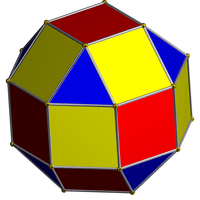 The pseudo-rhombicuboctahedron has a single vertex figure, 3.4.4.4, but with a twist on one square cupola. Unlike the (untwisted) rhombicuboctahedron it is not vertex transitive. This is a Johnson solid, and most authors do not consider it to be Archimedean. |
In geometry, an Archimedean solid is one of the 13 solids first enumerated by Archimedes. They are the semi-regular convex polyhedrons composed of regular polygons meeting in identical vertices, excluding the 5 Platonic solids (which are composed of only one type of polygon) and excluding the prisms and antiprisms. They differ from the Johnson solids, whose regular polygonal faces do not meet in identical vertices.
"Identical vertices" means that for any two vertices, there is a global isometry of the entire solid that takes one vertex to the other. Branko Grünbaum (2009) pointed out a widespread error in the literature on Archimedan solids: some authors only require that the faces that meet at one vertex are related by a local isometry to the faces that meet at any other vertex, and incorrectly claim that there are 13 solids satisfying this definition. However there are in fact 14, because the elongated square gyrobicupola (pseudo-rhombicuboctahedron) is the unique convex polyhedron that has regular polygons meeting in the same way at each vertex, but that does not have a global symmetry taking any vertex to any other vertex. Because of this Grünbaum suggested that the elongated square gyrobicupola should be counted as an Archimedean solid, which would give 14 Archimedean solids, but most authors (including Archimedes himself) do not include it in their lists of 13 Archimedean solids.
Prisms and antiprisms, whose symmetry groups are the dihedral groups, are generally not considered to be Archimedean solids, even though their faces are regular polygons and their symmetry groups act transitively on their vertices. Excluding these two infinite families, there are 13 Archimedean solids. All the Archimedan solids (but not the elongated square gyrobicupola) can be made via Wythoff constructions from the Platonic solids with tetrahedral, octahedral and icosahedral symmetry.
Origin of name
The Archimedean solids take their name from Archimedes, who discussed them in a now-lost work. Pappus refers to it, stating that Archimedes listed 13 polyhedra.[1] During the Renaissance, artists and mathematicians valued pure forms with high symmetry, and by around 1620 Johannes Kepler had completed the rediscovery of the 13 polyhedra,[2] as well as defining the prisms, antiprisms, and the non-convex solids known as Kepler-Poinsot polyhedra.
Kepler may have also found the elongated square gyrobicupola (pseudorhombicuboctahedron): at least, he once stated that there were 14 Archimedean solids. However, his published enumeration only includes the 13 uniform polyhedra, and the first clear statement of the pseudorhombicuboctahedron's existence was made in 1905, by Duncan Sommerville.[1]
Classification
There are 13 Archimedean solids (not counting the elongated square gyrobicupola; 15 if the mirror images of two enantiomorphs, see below, are counted separately).
Here the vertex configuration refers to the type of regular polygons that meet at any given vertex. For example, a vertex configuration of (4,6,8) means that a square, hexagon, and octagon meet at a vertex (with the order taken to be clockwise around the vertex).
| Name (Alternative name) |
Schläfli Coxeter |
Transparent | Solid | Net | Vertex figure |
Faces | Edges | Vert. | Volume (unit edges) |
Point group | |
|---|---|---|---|---|---|---|---|---|---|---|---|
| truncated tetrahedron | t{3,3} |
(Animation) |
 |
|
3.6.6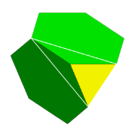 |
8 | 4 triangles 4 hexagons |
18 | 12 | 2.710576 | Td |
| cuboctahedron (rhombitetratetrahedron) | r{4,3} or rr{3,3} |
(Animation) |
 |
 |
3.4.3.4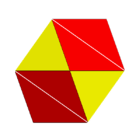 |
14 | 8 triangles 6 squares |
24 | 12 | 2.357023 | Oh |
| truncated cube | t{4,3} |
 (Animation) |
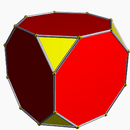 |
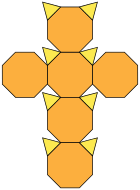 |
3.8.8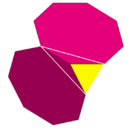 |
14 | 8 triangles 6 octagons |
36 | 24 | 13.599663 | Oh |
| truncated octahedron (truncated tetratetrahedron) | t{3,4} or tr{3,3} |
(Animation) |
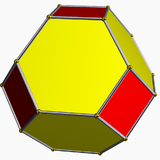 |
 |
4.6.6 |
14 | 6 squares 8 hexagons |
36 | 24 | 11.313709 | Oh |
| rhombicuboctahedron (small rhombicuboctahedron) | rr{4,3} |
 (Animation) |
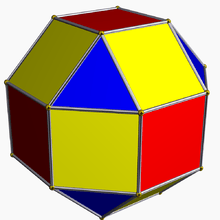 |
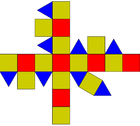 |
3.4.4.4 |
26 | 8 triangles 18 squares |
48 | 24 | 8.714045 | Oh |
| truncated cuboctahedron (great rhombicuboctahedron) | tr{4,3} |
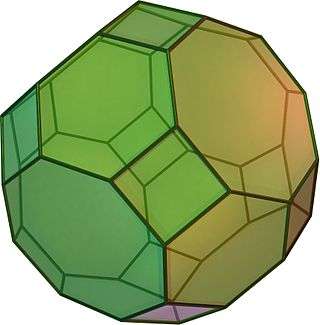 (Animation) |
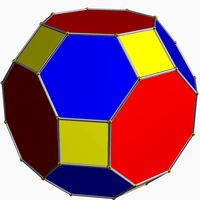 |
|
4.6.8 |
26 | 12 squares 8 hexagons 6 octagons |
72 | 48 | 41.798990 | Oh |
| snub cube (snub cuboctahedron) | sr{4,3} |
(Animation) |
 |
|
3.3.3.3.4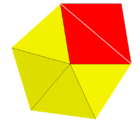 |
38 | 32 triangles 6 squares |
60 | 24 | 7.889295 | O |
| icosidodecahedron | r{5,3} |
 (Animation) |
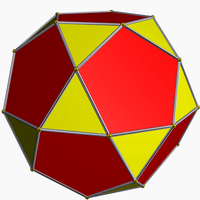 |
|
3.5.3.5 |
32 | 20 triangles 12 pentagons |
60 | 30 | 13.835526 | Ih |
| truncated dodecahedron | t{5,3} |
(Animation) |
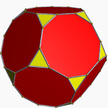 |
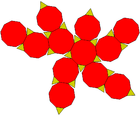 |
3.10.10 |
32 | 20 triangles 12 decagons |
90 | 60 | 85.039665 | Ih |
| truncated icosahedron | t{3,5} |
 (Animation) |
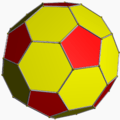 |
 |
5.6.6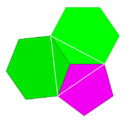 |
32 | 12 pentagons 20 hexagons |
90 | 60 | 55.287731 | Ih |
| rhombicosidodecahedron (small rhombicosidodecahedron) | rr{5,3} |
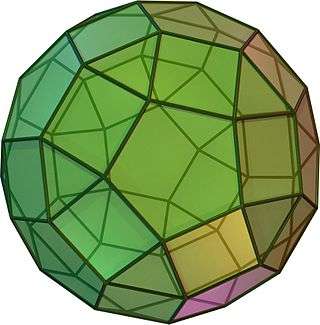 (Animation) |
 |
 |
3.4.5.4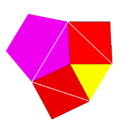 |
62 | 20 triangles 30 squares 12 pentagons |
120 | 60 | 41.615324 | Ih |
| truncated icosidodecahedron (great rhombicosidodecahedron) | tr{5,3} |
 (Animation) |
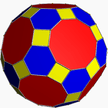 |
|
4.6.10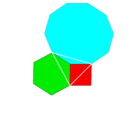 |
62 | 30 squares 20 hexagons 12 decagons |
180 | 120 | 206.803399 | Ih |
| snub dodecahedron (snub icosidodecahedron) | sr{5,3} |
 (Animation) |
 |
|
3.3.3.3.5 |
92 | 80 triangles 12 pentagons |
150 | 60 | 37.616650 | I |
Some definitions of semiregular polyhedron include one more figure, the elongated square gyrobicupola or "pseudo-rhombicuboctahedron".[3]
Properties
The number of vertices is 720° divided by the vertex angle defect.
The cuboctahedron and icosidodecahedron are edge-uniform and are called quasi-regular.
The duals of the Archimedean solids are called the Catalan solids. Together with the bipyramids and trapezohedra, these are the face-uniform solids with regular vertices.
Chirality
The snub cube and snub dodecahedron are known as chiral, as they come in a left-handed (Latin: levomorph or laevomorph) form and right-handed (Latin: dextromorph) form. When something comes in multiple forms which are each other's three-dimensional mirror image, these forms may be called enantiomorphs. (This nomenclature is also used for the forms of certain chemical compounds).
Construction of Archimedean solids

The different Archimedean and Platonic solids can be related to each other using a handful of general constructions. Starting with a Platonic solid, truncation involves cutting away of corners. To preserve symmetry, the cut is in a plane perpendicular to the line joining a corner to the center of the polyhedron and is the same for all corners. Depending on how much is truncated (see table below), different Platonic and Archimedean (and other) solids can be created. Expansion or cantellation involves moving each face away from the center (by the same distance so as to preserve the symmetry of the Platonic solid) and taking the convex hull. Expansion with twisting also involves rotating the faces, thus breaking the rectangles corresponding to edges into triangles. The last construction we use here is truncation of both corners and edges. Ignoring scaling, expansion can also be viewed as truncation of corners and edges but with a particular ratio between corner and edge truncation.
| Symmetry | Tetrahedral |
Octahedral |
Icosahedral | |||
|---|---|---|---|---|---|---|
| Starting solid Operation | Symbol {p,q} |
Tetrahedron {3,3}  | Cube {4,3} 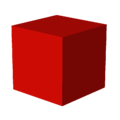 | Octahedron {3,4}  | Dodecahedron {5,3} 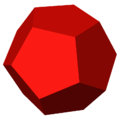 | Icosahedron {3,5} 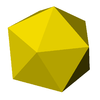 |
| Truncation (t) | t{p,q} |
truncated tetrahedron | truncated cube | truncated octahedron | truncated dodecahedron | truncated icosahedron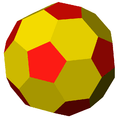 |
| Rectification (r) Ambo (a) | r{p,q} |
tetratetrahedron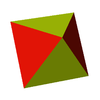 | cuboctahedron | icosidodecahedron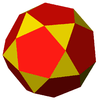 | ||
| Bitruncation (2t) Dual kis (dk) | 2t{p,q} |
truncated tetrahedron | truncated octahedron | truncated cube | truncated icosahedron | truncated dodecahedron |
| Birectification (2r) Dual (d) | 2r{p,q} |
tetrahedron | octahedron | cube | icosahedron | dodecahedron |
| cantellation (rr) Expansion (e) | rr{p,q} |
rhombitetratetrahedron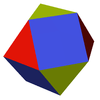 | rhombicuboctahedron | rhombicosidodecahedron  | ||
| Snub rectified (sr) Snub (s) | sr{p,q} |
snub tetratetrahedron | snub cuboctahedron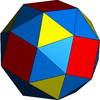 | snub icosidodecahedron | ||
| Cantitruncation (tr) Bevel (b) | tr{p,q} |
truncated tetratetrahedron | truncated cuboctahedron | truncated icosidodecahedron | ||
Note the duality between the cube and the octahedron, and between the dodecahedron and the icosahedron. Also, in part due to self-duality of the tetrahedron, only one Archimedean solid has only tetrahedral symmetry.
See also
- Aperiodic tiling
- Archimedean graph
- List of uniform polyhedra
- Toroidal polyhedron
- Quasicrystal
- semiregular polyhedron
- regular polyhedron
- uniform polyhedron
- Icosahedral twins
Notes
- 1 2 Grünbaum (2009).
- ↑ Field J., Rediscovering the Archimedean Polyhedra: Piero della Francesca, Luca Pacioli, Leonardo da Vinci, Albrecht Dürer, Daniele Barbaro, and Johannes Kepler, Archive for History of Exact Sciences, 50, 1997, 227
- ↑ Malkevitch (1988), p. 85
References
- Jayatilake, Udaya (March 2005). "Calculations on face and vertex regular polyhedra". Mathematical Gazette. 89 (514): 76–81.
- Grünbaum, Branko (2009), "An enduring error", Elemente der Mathematik, 64 (3): 89–101, doi:10.4171/EM/120, MR 2520469. Reprinted in Pitici, Mircea, ed. (2011), The Best Writing on Mathematics 2010, Princeton University Press, pp. 18–31.
- Williams, Robert (1979). The Geometrical Foundation of Natural Structure: A Source Book of Design. Dover Publications, Inc. ISBN 0-486-23729-X. (Section 3-9)
- Malkevitch, Joseph (1988), "Milestones in the history of polyhedra", in Senechal, M.; Fleck, G., Shaping Space: A Polyhedral Approach, Boston: Birkhäuser, pp. 80–92.
- Anthony Pugh (1976). Polyhedra: A visual approach. California: University of California Press Berkeley. ISBN 0-520-03056-7. Chapter 2
External links
- Archimedean Solids by Eric W. Weisstein, Wolfram Demonstrations Project.
- Paper models of Archimedean Solids and Catalan Solids
- Free paper models(nets) of Archimedean solids
- The Uniform Polyhedra by Dr. R. Mäder
- Virtual Reality Polyhedra, The Encyclopedia of Polyhedra by George W. Hart
- Penultimate Modular Origami by James S. Plank
- Interactive 3D polyhedra in Java
- Solid Body Viewer is an interactive 3D polyhedron viewer which allows you to save the model in svg, stl or obj format.
- Stella: Polyhedron Navigator: Software used to create many of the images on this page.
- Paper Models of Archimedean (and other) Polyhedra